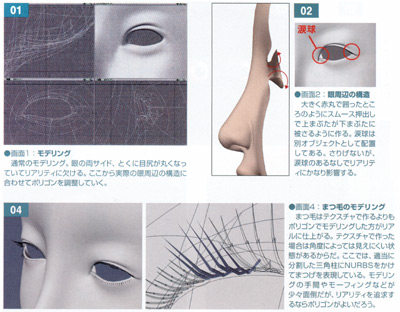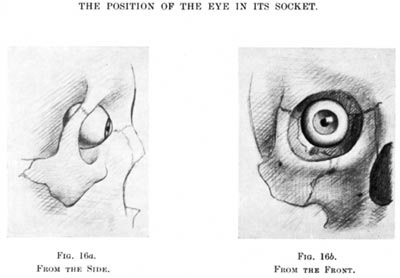I just got the latest design magazines from Japan, and this month is the usual excellent package of amazing graphics tips. This month's MdN has a special paper cover, it's a laminated plastic with sparkly holographic pixels all over it. I was especially interested in GW magazine, they have a lesson on 3D CG modelling of the eye. This lesson focuses on a particularly Japanese characteristic, the eyelid and epicanthic fold.

The problem is that none of these designers really understands the bigger picture of cranial anatomy. These models are skin deep, they do not have the presence that is possible if the figures are based more accurately on familiar human anatomy. These diagrams are from "Anatomy for Artists" and dates back to 1923.

The author of this anatomy book is an eye surgeon, and describes ethnic variations on the eye structure in detail, such as the epicanthic fold in the corners of the eyes of Asians. However, the underlying structure of the orbit, supranasal prominence, and malar bone are fairly universal between all human genotypes, and are not accurately proportioned in the Japanese CG design. The face is too flat, the eyes are not set deeply enough, without sufficient depth in the structures of the nose, cheekbones, and eyes. The nose and lips are too low because the maxilla structure is incorrect. You can clearly see the differences since both of the illustrators show the same profile.
The theme of most western academic drawing studies is anatomical, to build figures from the skeleton and musculature outwards to the skin. The Japanese diagrams illustrate the surface of almost the same area, but there are differences in proportion that are not very realistic. I notice that Japanese designs tend to exaggerate the size of the eyes, like comic books. Unfortunately this doesn't work very well in 3D work, since the face is viewed as a whole and any changes in proportion are instantly obvious. The subtle changes made by the CG artists can't really be accounted for as stylistic variants, since they're trying for accuracy in these demonstrations. The fact is, this is CG art by nonartists, who do not know the underlying skeleton and musculature that makes a face work.

The problem is that none of these designers really understands the bigger picture of cranial anatomy. These models are skin deep, they do not have the presence that is possible if the figures are based more accurately on familiar human anatomy. These diagrams are from "Anatomy for Artists" and dates back to 1923.

The author of this anatomy book is an eye surgeon, and describes ethnic variations on the eye structure in detail, such as the epicanthic fold in the corners of the eyes of Asians. However, the underlying structure of the orbit, supranasal prominence, and malar bone are fairly universal between all human genotypes, and are not accurately proportioned in the Japanese CG design. The face is too flat, the eyes are not set deeply enough, without sufficient depth in the structures of the nose, cheekbones, and eyes. The nose and lips are too low because the maxilla structure is incorrect. You can clearly see the differences since both of the illustrators show the same profile.
The theme of most western academic drawing studies is anatomical, to build figures from the skeleton and musculature outwards to the skin. The Japanese diagrams illustrate the surface of almost the same area, but there are differences in proportion that are not very realistic. I notice that Japanese designs tend to exaggerate the size of the eyes, like comic books. Unfortunately this doesn't work very well in 3D work, since the face is viewed as a whole and any changes in proportion are instantly obvious. The subtle changes made by the CG artists can't really be accounted for as stylistic variants, since they're trying for accuracy in these demonstrations. The fact is, this is CG art by nonartists, who do not know the underlying skeleton and musculature that makes a face work.
That's pretty funny that you call the Japanese CG'ers "non-artists", since the "unrealistic" CG-models the Japanese make look absolutely awesome in videogames, animes, etc. Yeah, the Japanese tend to overexaggerate certain features. They are based on their manga and anime stylings and are quite aesthetically pleasing. Compare the CG characters from Resident Evil:Code Veronica to any other non-Japanese CG characters. The stuff they put out in Japan almost always looks better than the more "realistic" stuff, such as American CG characters. Sure they are not realistic like actual human anatomy like you said, but it's not supposed to be. It was wrong of you to call them "non-artists".
You're missing the point. These examples were designed for high-rez print, using top end systems like Softimage and Maya. They're intended to demonstrate 3D modelling of anatomical features as accurately as possible, not how to caricature them for video or other formats. The magazine is full of misproportioned faces, I should scan some more and you'd see what I'm talking about. They all try for accuracy, but they fail for reasons the modeller just doesn't quite understand. That is why the 3D CG modellers are not artists, any artist knows the basics of portraiture, and those principles would apply here.
I am looking for a book, or some source, that will teach me, layer for layer, the muscles of the human face, from skull to skin.
I am trying to learn anatomy for clay scultpting and the numerous books I have collected all have composite pages with no reference to which muscle is on top of the next muscle, nor to its full size so that these can be replicated in clay to understand the overall effect, and their rigidity, on the facial 'personality'.
Any ideas? I know there is a book but I have not seen it for over 25 years and NOW of course, I am ready to start.
thanks
Hi!!! whats is the neme of this book "Anatomy for Artists" and dates back to 1923.
(whats is the book name?)
Thanks
Cheers
[The name of the book is "Anatomy for Artists" and was published in 1923, just like I said in the article. I can not cite the author since my book is in storage and inaccessible. As I noted, the author was a doctor and surgeon. That might help you locate it. Unfortunately, there have been several dozen books with the same title published over the years. --Charles]